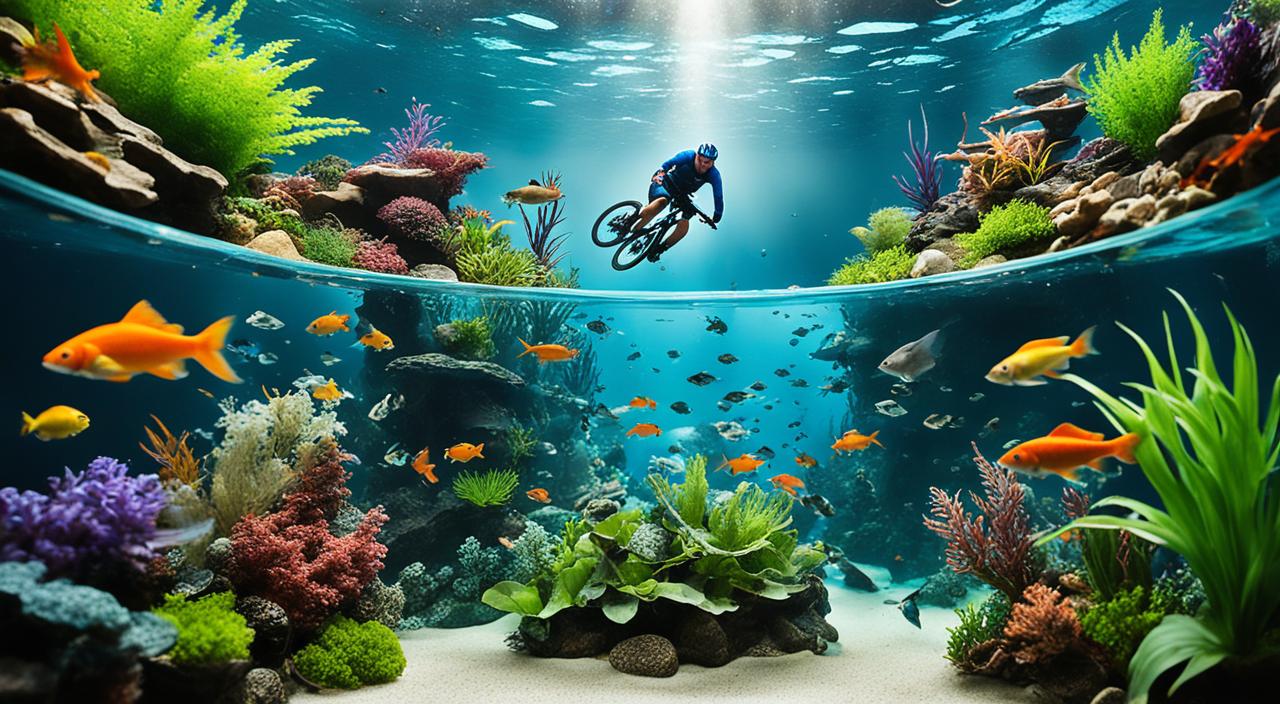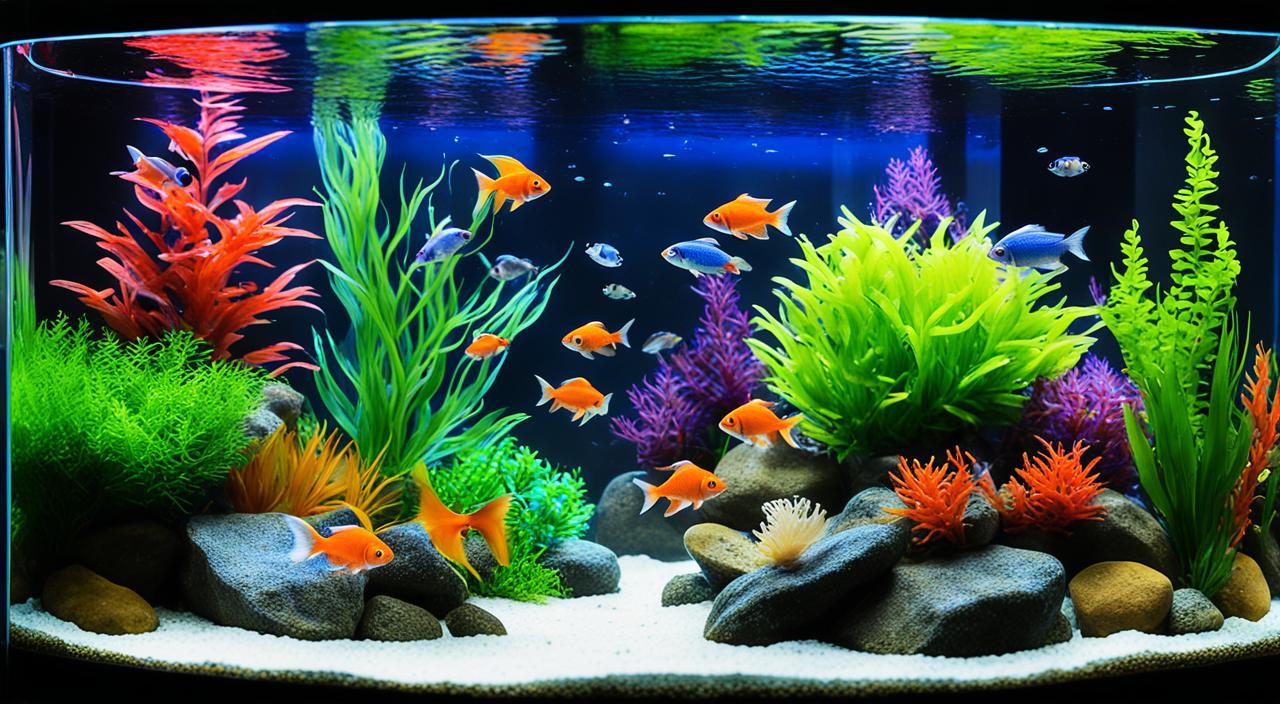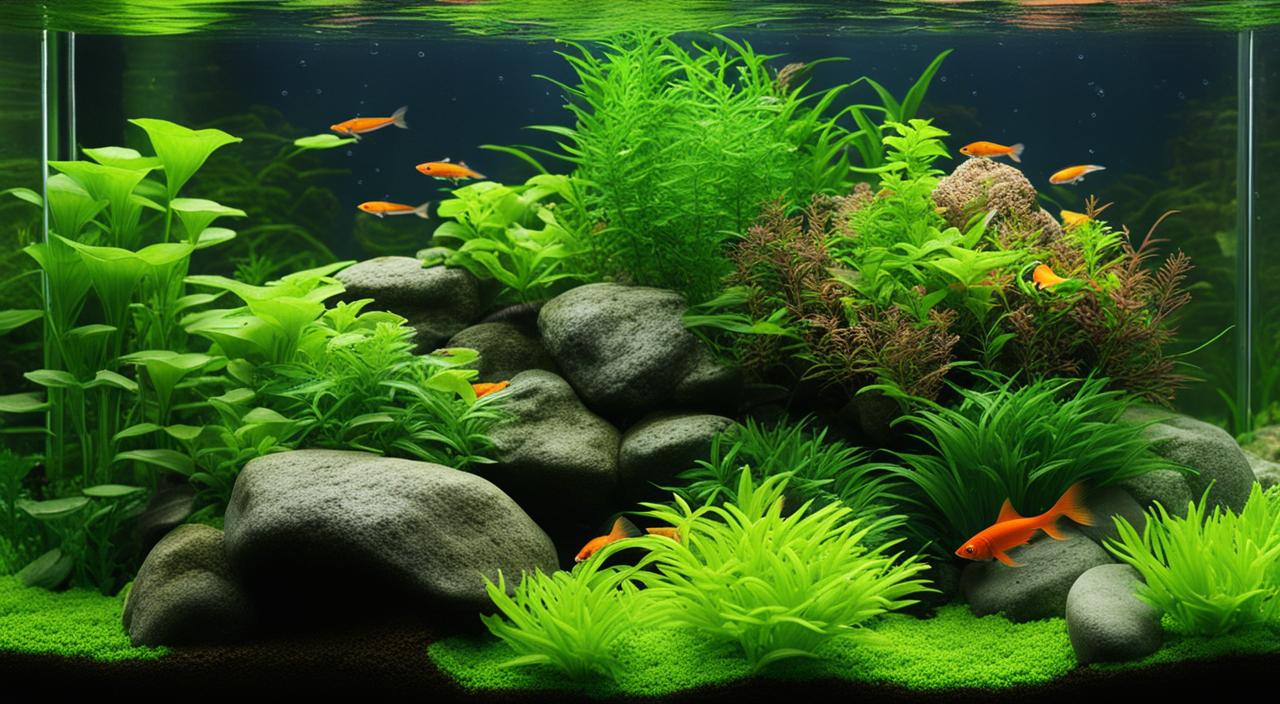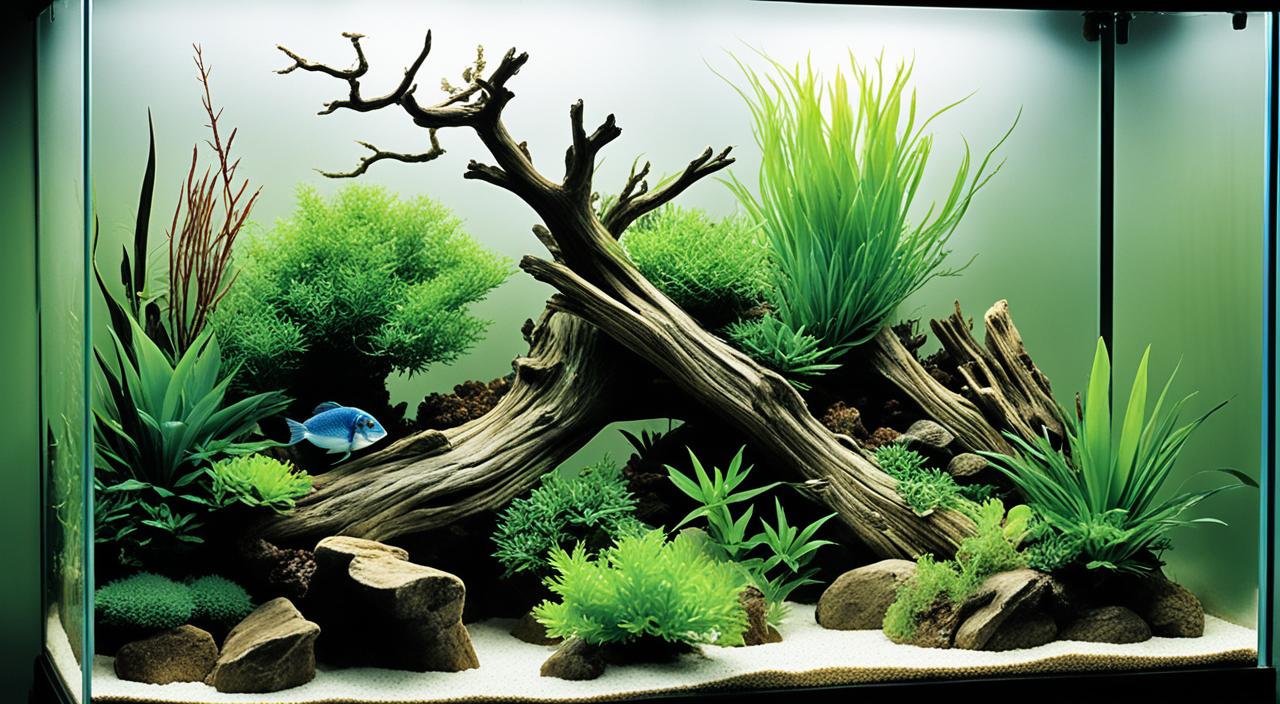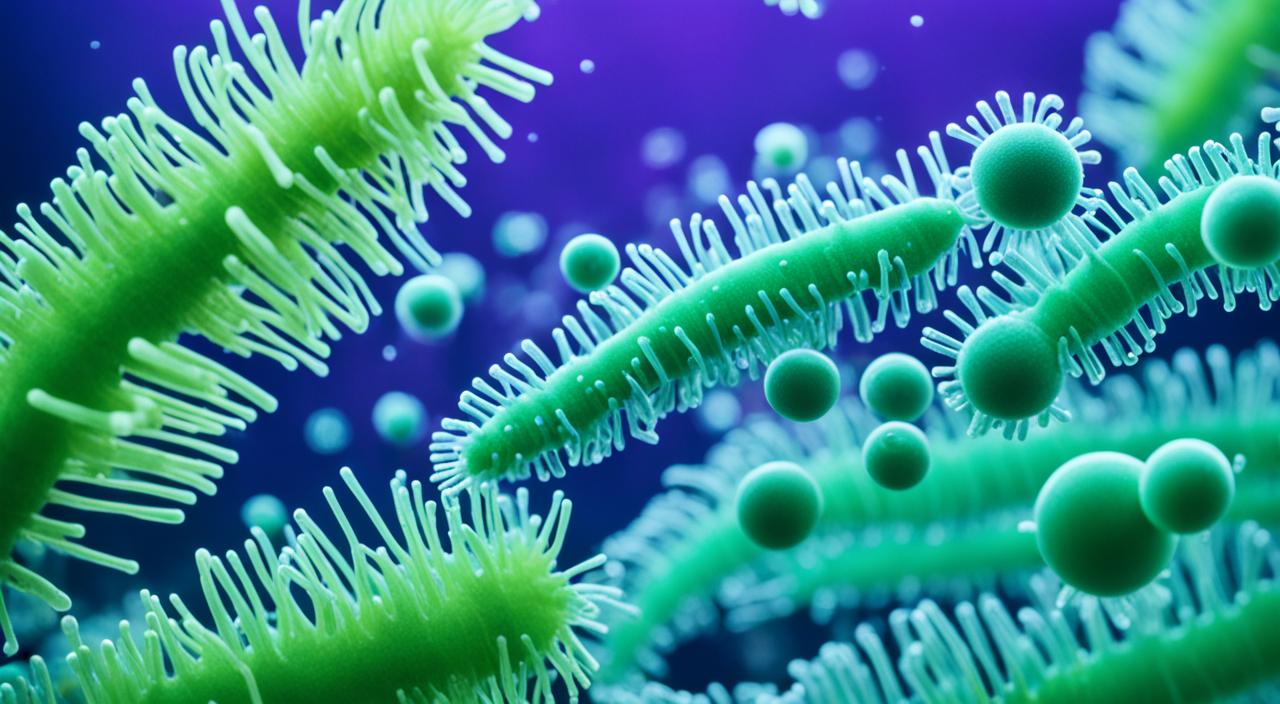Welcome to the exciting world of cycling with fish! If you’re a fish lover looking for a unique and sustainable way to enhance your aquarium setup, you’ve come to the right place. In this article, I will guide you through the art of establishing a thriving ecosystem in your aquarium while enjoying the adventures of cycling. Prepare to embark on fish-themed cycling experiences, explore fish-filled cycling destinations, and witness fascinating fish habitats as you pedal through nature’s beauty.
Creating a fish-friendly cycling tour starts with understanding the essential process of aquarium cycling. You can ensure their health and happiness by harnessing the power of beneficial bacteria and providing a safe environment for your aquatic friends. From the nitrogen cycle to different cycling methods, we’ll cover all the necessary information to help you create a sustainable and thriving aquarium ecosystem.
So grab your cycling gear and join me on this incredible cycling journey with fish. Together, we’ll unlock the secrets of fish conservation cycling trips and discover the beauty of cycling routes with fish sightings.
Key Takeaways:
- Establishing a healthy aquarium ecosystem through cycling enhances the well-being of your fish.
- Understanding the aquarium nitrogen cycle is crucial for maintaining a balanced environment.
- There are different methods of cycling your aquarium, including fish-in cycling, fishless cycling, and cycling with plants.
- Fish-in cycling involves gradually introducing fish and carefully monitoring water quality.
- Fishless cycling is a safe and effective approach that utilizes ammonia dosing and bacterial seeding.
Understanding the Aquarium Nitrogen Cycle
The aquarium nitrogen cycle is a crucial process that ensures the health and well-being of your fish. It involves converting and consuming nitrogen compounds in the water by beneficial bacteria and plants. Let’s dive deeper into how this cycle works.
The Nitrogen Cycle Process
When fish produce waste, primarily in the form of ammonia, it can be toxic to them if left untreated. However, beneficial bacteria in the tank play a vital role in converting ammonia into nitrite, which is also toxic but less harmful than ammonia. Another group of beneficial bacteria then converts the nitrite into nitrate, which is the least harmful form of nitrogen waste.
Aquarium plants can utilize nitrate as a source of nutrition, and, in turn, they release oxygen into the water, creating a healthy environment for the fish. Regular water changes help remove excess nitrates, maintaining a balance in the tank. This continuous cycle of waste conversion and nutrient absorption by bacteria and plants is known as the aquarium nitrogen cycle.
Importance of Beneficial Bacteria
Beneficial bacteria are critical to the nitrogen cycle as they facilitate the conversion of toxic waste compounds. These bacteria establish themselves naturally in the aquarium, primarily in the filter media, substrate, and decorations. It is essential to allow sufficient time for the bacteria to multiply and establish their colonies before introducing fish into a new tank.
Beneficial bacteria convert ammonia to nitrite during the initial phase of the nitrogen cycle. Nitrite is then converted to nitrate by a different group of bacteria. Both types of bacteria play essential roles in maintaining a healthy and balanced ecosystem for your fish.
Critical Components of the Nitrogen Cycle
There are three critical components of the aquarium nitrogen cycle:
- Ammonia: Ammonia is the primary waste product produced by fish through their respiration and excretion. It is highly toxic to fish and needs to be converted to less harmful forms.
- Nitrite: Nitrite is the intermediate product of the nitrogen cycle. It is also toxic to fish but less harmful than ammonia. Nitrite is converted to nitrate through the beneficial bacteria in the aquarium.
- Nitrate: Nitrate is the final product of the nitrogen cycle. While it is less harmful than ammonia and nitrite, high nitrate levels can still harm fish health. Regular water changes and the presence of aquarium plants help keep nitrate levels in check.
Understanding the aquarium nitrogen cycle is crucial for maintaining a thriving aquarium. You can ensure your fish have a safe and comfortable habitat by providing a suitable environment for beneficial bacteria and plants to flourish.
Methods of Cycling Your Aquarium
When it comes to cycling your aquarium, there are several techniques you can choose from, each with its advantages and considerations. Whether you prefer a traditional approach or want to create a natural and visually appealing ecosystem, there’s a method that’s right for you. Let’s explore the three main aquarium cycling techniques: Fish-In Cycling, Fishless Cycling, and Cycling with Plants.
Fish-In Cycling
Fish-In Cycling is the most common method used by aquarium enthusiasts. This technique involves adding fish directly to the tank to produce ammonia, which the beneficial bacteria will consume and convert into less harmful compounds. It’s important to choose hardy fish species tolerant of cycling conditions and closely monitor the water quality during this process. This technique lets you enjoy your fish from the start and observe the cycling process firsthand.
Fishless Cycling
If you prefer to establish a healthy aquarium ecosystem without subjecting fish to potentially harmful water conditions, Fishless Cycling is a suitable option. This technique involves adding a source of ammonia, such as fish food or ammonia drops, to the tank to feed the beneficial bacteria. By providing this ammonia source, the bacteria can grow and establish themselves without the presence of fish. Regular water testing is crucial to monitor the cycle’s progress and ensure a safe environment for future fish inhabitants.
Cycling with Plants
If you want to create a natural and visually appealing aquarium, consider Cycling with Plants. This method utilizes live aquarium plants to consume ammonia and nitrates, providing a secondary form of filtration. The plants enhance the water quality by absorbing harmful compounds and creating a lush and vibrant environment for your fish. Cycling with Plants is a popular choice for aquarists who value the aesthetics and ecological benefits of live plants in their aquariums.
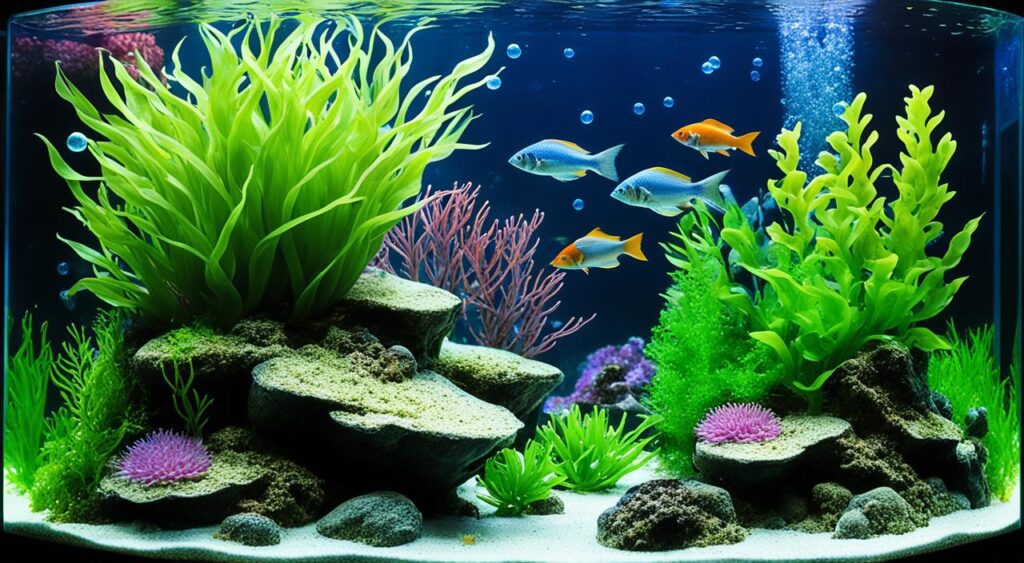
Now that we’ve explored the three main aquarium cycling techniques, you can choose the method that best suits your preferences and experience level. Whether you opt for Fish-In Cycling, Fishless Cycling, or Cycling with Plants, remember to monitor the water parameters regularly to ensure the establishment of a healthy and balanced aquarium ecosystem.
| Technique | Advantages | Considerations |
|---|---|---|
| Fish-In Cycling | Immediate enjoyment of fish | Higher stress levels for fish |
| Fishless Cycling | No harm to fish | Requires monitoring and patience |
| Cycling with Plants | Natural filtration and aesthetics | May require additional lighting and care |
How to Fish-In Cycle Your Aquarium
To successfully fish-in cycle your aquarium, you should gradually introduce a few hardy fish to your tank and closely monitor the water quality. Start with a small number of fish and gradually increase the stocking over time. Monitor ammonia and nitrite levels using water testing kits and perform regular partial water changes to keep the water parameters within a safe range. This method allows you to observe and enjoy your fish while the beneficial bacteria grow and establish a healthy ecosystem.
The Gradual Introduction of Hardy Fish
When fishing-in cycling your aquarium, starting with a small number of hardy fish is essential. Choose species known for their ability to withstand cycling conditions, such as Danios or Guppies. This gradual introduction allows the beneficial bacteria to grow and adapt to the increasing ammonia levels produced by the fish.
Closely Monitor Water Quality
During the fish-in cycling process, test the water for ammonia and nitrite levels using water testing kits. Monitoring these parameters will help you ensure that the cycling process is progressing properly and that your fish are not subjected to harmful toxins. Aim to keep ammonia and nitrite levels close to zero to prevent stress and illness in your fish.
Perform Regular Partial Water Changes
Perform regular partial water changes to maintain optimal water quality and keep ammonia and nitrite levels in check. Replace some aquarium water with fresh, dechlorinated water to dilute accumulated toxins, replenish essential minerals, and maintain a healthy environment for your fish. It is recommended to perform water changes of 20-30% weekly or as needed based on water quality testing results.
| Step | Action |
|---|---|
| 1 | Introduce a small number of hardy fish to your aquarium. |
| 2 | Monitor ammonia and nitrite levels using water testing kits. |
| 3 | Perform regular partial water changes to maintain water quality. |
| 4 | Gradually increase fish stocking over time. |
Fishless Cycling: A Safe and Effective Approach
When it comes to establishing a healthy aquarium ecosystem, fishless cycling is a safe and effective approach that ensures the well-being of your fish. This method allows beneficial bacteria to grow and consume ammonia without subjecting your fish to potentially harmful conditions. By dosing the tank with a source of ammonia, such as fish food, you can kickstart the cycling process and create a thriving habitat for your aquatic pets.
To expedite the cycling process, you can introduce bacterial seeding from an established tank or utilize bacterial additives designed to accelerate the cycle. These additives contain concentrated beneficial bacteria that quickly establish themselves in your tank, aiding in the breakdown of ammonia and the subsequent conversion to nitrite and nitrate.
Regular water quality testing is crucial during the fishless cycling period. Monitoring the ammonia, nitrite, and nitrate levels ensures the cycling process is progressing correctly. Testing kits designed for aquarium use provide accurate readings and allow you to take timely action if the parameters need adjustment.
Accelerated cycling saves time and allows you to introduce fish into a stable and healthy environment sooner. With fishless cycling, you can establish a balanced aquarium ecosystem and provide your fish with a safe and stress-free home.
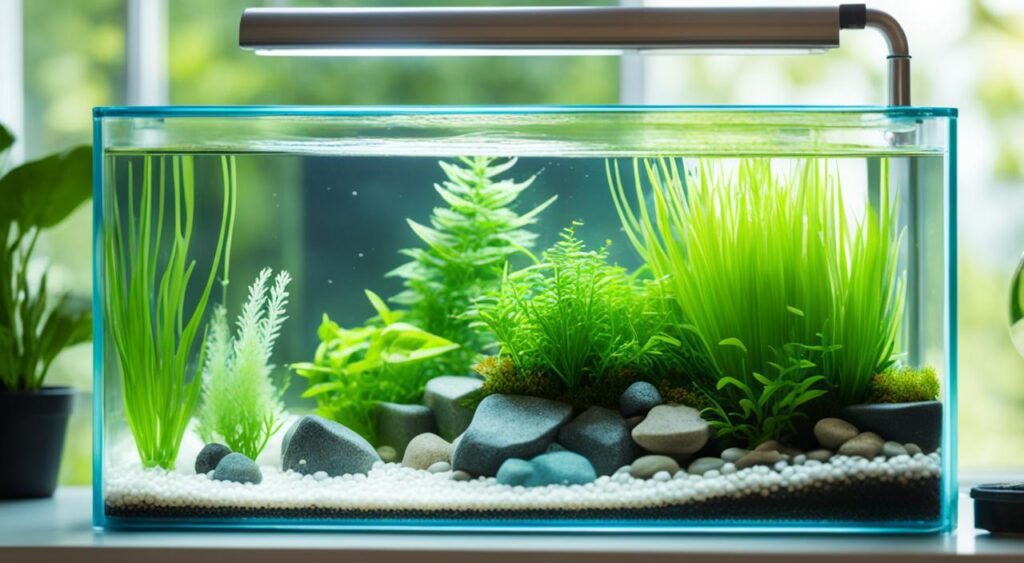
| Advantages of Fishless Cycling: | Considerations: |
|---|---|
|
|
Cycling with Plants: Creating a Natural Ecosystem
Cycling with plants is a popular method for creating a natural and visually appealing aquarium ecosystem. Live aquarium plants are vital in consuming nitrogen waste, including ammonia and nitrates, more effectively than bacteria alone. By incorporating live plants into your tank setup, you can establish a balanced and self-sustaining ecosystem that promotes your fish’s overall health and well-being.
Their ability to contribute beneficial bacteria and enhance the biological filtration process is a significant advantage when cycling with plants. These plants act as biological filters, absorbing and utilizing nitrogen waste as a nutrient source for their growth. As a result, the plants help to reduce ammonia and nitrate levels, creating a healthier and more stable environment for your fish.
One of the key benefits of incorporating live aquarium plants is the aesthetic beauty they bring to your tank. Their lush foliage, vibrant colours, and natural habitats create a visually captivating underwater landscape. Not only does this enhance the overall appeal of your aquarium, but it also provides a more natural and stimulating environment for your fish to thrive.
Furthermore, cycling with plants promotes a harmonious balance within the ecosystem. The plants and fish form a symbiotic relationship, with the plants providing shelter, shade, and oxygen to the fish, while the fish provide carbon dioxide and nutrients through their waste, benefiting the growth of the plants.
To maximize the benefits of cycling with plants, consider selecting the appropriate live aquarium plants suitable for your tank’s conditions and the specific needs of your fish. Research the various plant species available and choose those compatible with your aquarium’s lighting, substrate, and water parameters. Proper plant care, including regular pruning, fertilization, and maintenance, is also essential to ensure their longevity and optimal performance within the ecosystem.
In conclusion, cycling with plants offers numerous advantages for creating a natural, visually appealing, and self-sustaining aquarium ecosystem. Incorporating live aquarium plants enhances biological filtration, reduces nitrogen waste levels, and promotes a healthier environment for your fish. Consider exploring the variety of live plants available and enjoy the beauty and benefits they bring to your planted tank.
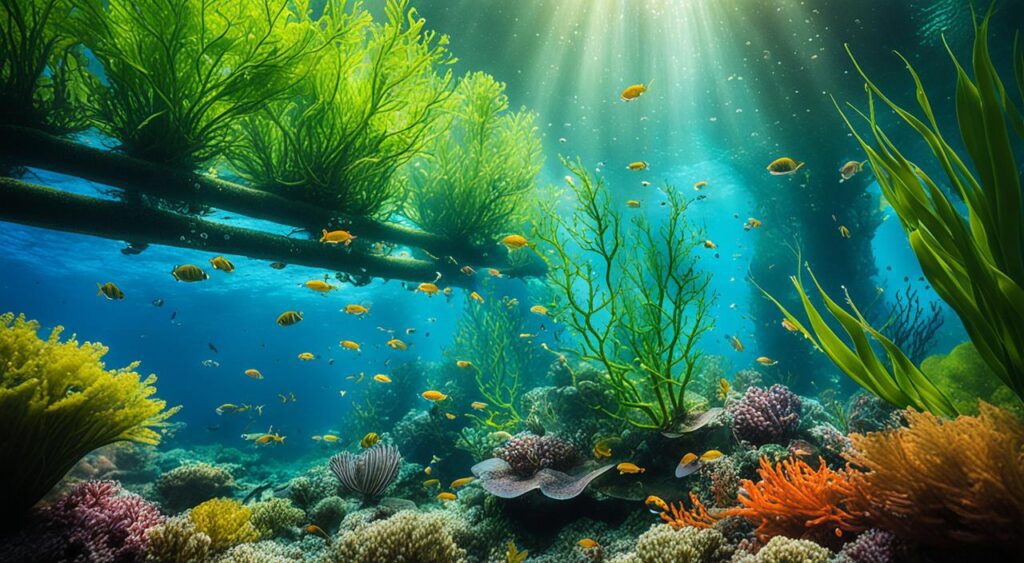
Tips for Successful Cycling and Aquarium Maintenance
Following a few key tips is essential to ensure successful cycling and long-term aquarium maintenance. First and foremost, regular water testing is crucial. Use a reliable water testing kit to monitor the water parameters and track the progress of the nitrogen cycle. This will help you ensure that the conditions in your aquarium are optimal for your fish’s health and well-being.
In addition to testing the water, performing partial water changes is essential. Regular water changes help maintain a stable and balanced environment in the aquarium, preventing the buildup of harmful substances and maintaining water quality. Aim to change about 10-25% of the water every one to two weeks, depending on the needs of your specific tank.
When introducing new fish to your aquarium, it’s vital to acclimate them properly. Allow the fish to adjust to the temperature and water chemistry of the tank gradually, minimizing stress and promoting a smoother transition. This can be done by floating the bag containing the fish in the tank for 15-20 minutes to equalize the temperature and then slowly adding small amounts of aquarium water into the bag over 30-40 minutes before releasing the fish.
Consider using bacterial additives to support the growth of beneficial bacteria in your tank. These additives can help accelerate the cycling process by introducing essential bacteria that aid in converting harmful substances like ammonia and nitrite into less toxic compounds. Follow the manufacturer’s instructions when using bacterial additives to ensure the best results.
FAQ
What is the aquarium nitrogen cycle?
The aquarium nitrogen cycle is a crucial process that ensures the health and well-being of your fish. It involves the conversion and consumption of nitrogen compounds by bacteria and plants in the water. When fish produce waste (ammonia), beneficial bacteria and plants absorb the toxic waste, converting it into less harmful compounds (nitrite and nitrate).
What are the different methods of cycling an aquarium?
There are several methods of cycling an aquarium, each with its own benefits and considerations. Fish-In Cycling is the most common method, where fish are added to the tank to produce ammonia for the bacteria to consume. Fishless Cycling involves dosing the tank with a source of ammonia, such as fish food, to allow the bacteria to grow. Cycling with Plants is a natural and visually appealing method that utilizes live aquarium plants to consume ammonia and nitrates.
How do I fish-in cycle my aquarium?
To successfully fish-in cycle your aquarium, you should gradually introduce a few hardy fish to your tank and closely monitor the water quality. Start with a small number of fish and gradually increase the stocking over time. Monitor ammonia and nitrite levels using water testing kits, and perform regular partial water changes to keep the water parameters within a safe range.
What is fishless cycling and how does it work?
Fishless cycling is a safe and effective approach to establish a healthy aquarium ecosystem without risking the well-being of your fish. This method involves dosing the tank with a source of ammonia, such as fish food, and allowing beneficial bacteria to grow and consume the ammonia. Regular water quality testing and monitoring are essential to ensure the cycling process is progressing properly.
How can I create a natural ecosystem in my aquarium with plants?
Cycling with plants is a popular method for creating a natural and visually appealing aquarium ecosystem. Live aquarium plants consume nitrogen waste, including ammonia and nitrates, more effectively than bacteria alone. By incorporating live plants into your tank setup, you can establish a balanced and self-sustaining ecosystem.
What are some tips for successful cycling and aquarium maintenance?
To ensure successful cycling and long-term aquarium maintenance, you should regularly test the water parameters using a reliable water testing kit to monitor the progress of the nitrogen cycle. Perform partial water changes as needed to maintain optimal water quality. When introducing new fish to the tank, acclimate them properly to minimize stress. Consider using bacterial additives to support the growth of beneficial bacteria and aid in the cycling process.

